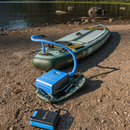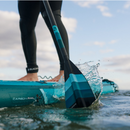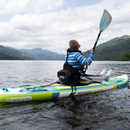Master Winter Paddle Boarding: Expert Tips for Cold Weather

As stand-up paddle boarding soars in popularity as a summertime sport, more paddlers are beginning to venture out in the winter as well. And for good reason. Summer in Canada is beautiful, but it’s also short. If you don’t want your paddle boards collecting dust for nine months of the year, you either have to fly south (like a Canada Goose!) or brave going out in colder weather. Fortunately, modern SUPs are fit for year-round use. And with the right skills and equipment, a reasonably confident paddler can extend their SUP season well into the shoulder months, and even winter. You can enjoy kaleidoscopic fall colors, bright snowy landscapes, or the budding freshness of spring, all from aboard your favorite SUP! And you also get to enjoy the added calm absent summer crowds.
Naturally, venturing out in colder weather presents a whole new set of risks and challenges for the intrepid paddler. The shoulder seasons are relatively easy to manage, but winter paddling can be more hazardous and warrants some extra caution. Falling in the water can be a dangerous possibility in sub-zero temperatures. The risks of hypothermia, frostbite, and drowning are all elevated, and the realities of dealing with cold, snow, and ice, might surprise you with unexpected difficulties. It pays to think ahead and learn from the mistakes of others. So, without further ado, here are some lessons we’ve learned over the years paddling throughout our cold, Canadian winters.

1. Clothing
For the confident paddler, warm winter clothing might seem adequate enough. A warm puffy jacket, winter gloves, a toque (that’s the Canadian name for a winter hat or beanie!) and some insulated pants and winter boots are certainly items you’ll want to bring along in cold temperatures. However, standard winter clothing will become heavy and burdensome if you fall in the water, making it hard to swim (no matter how infrequently you fall, you should always be prepared for it to happen!) and won’t do much to fend off the cold once soaked with water. For those reasons, you absolutely should wear a lifejacket (hey, it’s extra insulation!) and a leash to prevent your SUP board from getting away from you!
To really cover your bases, I’d recommend a winter wetsuit. Neoprene wetsuits are surprisingly inexpensive, readily available, and only a fraction of the cost of a dry suit—and there are options designed to keep you warm in freezing temperatures. They provide an excellent insulating layer and unlike standard winter clothing, will protect you in the event that you fall in. We’ve remained quite comfortable in 5mm neoprene wetsuits well into sub-zero temperatures, and you can always layer dry winter clothing on top to stay comfortable. These won’t keep you warm if you plan to get in and out of the water, as they’re not as effective in the air, but will at least provide enough protection that you can get safely back to somewhere warm, in the event you fall in.
Neoprene gloves, hoods, and footwear are also available, and will suffice for modestly cold temperatures. However, these items don’t perform as well in the air as they do in the water, and for that reason I most often elect for some winter work gloves, wool socks in waterproof hikers, and a nice warm toque instead.
Of course, the best option is a full dry suit, but a good one will likely cost you more than your board. If you plan to do a lot of winter paddling, it might be worth the investment.
2. A Dry Bag & Emergency Gear
In the event you do fall in the water, you’ll want to have a towel and a stash of backup clothing and additional layers readily available. If we are planning to go any distance, we keep these supplies in a dry bag on the front of the board. A dry bag is one item that I rarely go without. It provides a secure place to keep your essentials and car keys and can be easily accessed on the water if secured to the cargo straps on the front of your board.
Choose a good quality waterproof bag to ensure your items don’t get wet, and keep in mind some materials become brittle in colder temperatures. As a side-tip, when you roll up the dry bag to secure it, make sure to trap some extra air inside (like a balloon!). If it’s airtight, it’s watertight, and the added buoyancy will ensure it doesn’t sink.
3. Water Access
In colder temperatures, it becomes more important that you stay dry. In the summer, it’s easy to wade out into the shallows to find enough depth for fin clearance and then start your paddle. In the winter, you will most likely want to avoid this so that your feet don’t get soaked and subsequently become ice-cubes once exposed again to the cold air. You’ll want to think ahead, and plan entry and exit where deeper water can be accessed right from shore, so that you can mount and unmount your board without getting your feet wet. If there’s ice along the shore, additional precautions should be taken (see below!).
4. Beware of Ice

If temperatures are sufficiently low that you might encounter ice on the water, be extremely cautious planning outings. It’s critical to note here that you should NEVER go out on river, streams, reservoirs, lakes with a current, or any form of flowing water where ice is possible or has already accumulated. The risk of being swept under the ice in moving water is too great, and if you encounter an impassible section of iced-up water, you won’t be able to paddle upstream to avoid it. If there’s ice, only well-known, perfectly still bodies of water should be considered, and even then, with extreme caution. It is highly likely the ice will prevent you from swimming safely to shore, so you need to think ahead and always have a plan to get out of the water should something go wrong.
In icy conditions, access to the water becomes one of the biggest hazards. The shallows will most likely be frozen, and if they’re not, it might be because the water is flowing. Don’t ever attempt to walk across unknown ice unless you have the skills and tools to assess it. The best option is to find an ice-free, deep-water access point where you can get on and off your board without getting your feet wet. The best (and often only) option here is a dock, as steep embankments are guaranteed to be slippery.
5. Bring Sand or Light Gravel if Paddling in Icy Conditions
Paddling in sub-zero temperatures means that you’ll most likely accumulate ice on the deck of your board. Proper footwear can go a long way to providing grip, but you might need some extra help to have sure footing and traction. We’ve learned to take a small bag of sand or light gravel to sprinkle on the deck as it becomes icy. It’s an environmentally friendly solution and helps to prevent slips and falls.

6. Inflating / Deflating Your Board
Inflating and deflating a SUP in cold temperatures is substantially more difficult than in the summer. The colder the temperature, the stiffer and more brittle the material will become. In freezing temperatures, any water or moisture in the valve might freeze and cause it to leak. Most northerners know, the colder the weather, the more likely it is for equipment to fail.
With that said, in temperatures below freezing, it is best to inflate and deflate your inflatable SUP board indoors or in a warm environment. If you must inflate and deflate outside, let the material warm up in the trunk of your car before unfolding it. If it’s particularly stiff and difficult to fold up again, loosely toss it in the back of your car, and worry about folding it properly once it’s warm. You might damage the board by forcing it. Of course, the iROCKER Electric Pump can go a long way to making inflating easier!
7. Expect A Drop in Pressure
To best protect your equipment, it is best to inflate indoors, but there’s a caveat here. Since the air that you are pumping into your board will be significantly warmer than the air and water outside, you will most likely see a significant drop in board pressure once the board cools down outside. This is because the pressure of the gas (air!) inside the board decreases with temperature, as it cools and becomes more dense. A rule of thumb often used for car tires is that for every 10°C, you can expect a pressure drop of about 1-2PSI. For Fahrenheit, the rule of thumb is about 1PSI for 10°F. You may have noticed this paddling in the summer too! When you fill your board up in the warm air on land, and subsequently expose it to much colder water temperatures, you’ll typically notice a slight loss of pressure.
The solution to this issue in the winter is to fill your board inside, then top it up once it has cooled down outside with cold dense air, so that you have full pressure. If you do this though, you’ll have to remember to let some air out before the board warms up again indoors – otherwise you can expect the rise in temperature to create an over-pressure situation.

----
Hopefully these tips are helpful to any paddlers braving the winter season! Here in Calgary, we’ve learned many of these lessons the hard way in temperatures as low as -20°C. This winter, being particularly cold at the onset, has frozen most of our local water bodies solid, but once the ice starts to dissipate, you can be sure we’ll be out on the water again. If you have any comments or tips and tricks of your own, share them in the comments below!
As always, happy paddling!
Just getting into paddle boarding? Check out our best-selling SUPs.






